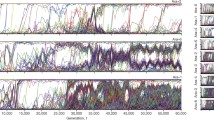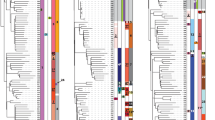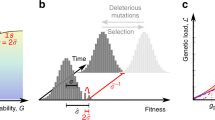Abstract
Recent phylogenetic studies reveal that Horizontal Gene Transfer (HGT) events are likely ubiquitous in the Tree of Life. However, our knowledge of HGT’s role in evolution and biological organization is very limited, mainly due to the difficulty tracing HGT events experimentally, and lack of computational models that can capture its dynamics. Here, we present a novel, multi-scale model of microbial populations with the capacity to study the effect of HGT on complex traits and regulatory network evolution. We describe a parallel load-balancing framework, which was developed to overcome the innate challenges of simulating evolving populations of such magnitude and complexity. Supercomputer simulations of in silico cells that mutate, compete, and evolve, show that HGT can significantly accelerate, but also disrupt, the emergence of advantageous traits in microbial populations. We show that HGT leaves a lasting imprint to gene regulatory networks when it comes to their size and sparsity. In any given experiment, we observed phenotypic variability that can be explained by individual gain and loss of function during evolution. Analysis of the fossil mutational and HGT event record, both for evolved and non-evolved populations, reveals that the distribution of fitness effect for HGT has different characteristics in terms of symmetry, shape and bias from its mutational counterpart. Interestingly, we observed that evolution can be accelerated when populations are exposed in correlated environments of increased complexity, especially in the presence of HGT.
Access this chapter
Tax calculation will be finalised at checkout
Purchases are for personal use only
Preview
Unable to display preview. Download preview PDF.
Similar content being viewed by others
References
Ragan, M.A., Beiko, R.G.: Lateral genetic transfer: open issues. Philosophical Transactions of the Royal Society B-Biological Sciences 364, 2241–2251 (2009)
Boto, L.: Horizontal gene transfer in evolution: facts and challenges. Proc. Biol. Sci. 277, 819–827 (2010)
Koonin, E.V., Makarova, K.S., Aravind, L.: Horizontal gene transfer in prokaryotes: Quantification and classification. Annual Review of Microbiology 55, 709–742 (2001)
Gogarten, J.P., Doolittle, W.F., Lawrence, J.G.: Prokaryotic evolution in light of gene transfer. Molecular Biology and Evolution 19, 2226–2238 (2002)
Koslowski, T., Zehender, F.: Towards a quantitative understanding of horizontal gene transfer: A kinetic model. Journal of Theoretical Biology 237, 23–29 (2005)
Nielsen, K.M., Townsend, J.P.: Monitoring and modeling horizontal gene transfer. Nature Biotechnology 22, 1110–1114 (2004)
Novozhilov, A.S., Karev, G.P., Koonin, E.V.: Mathematical modeling of evolution of horizontally transferred genes. Molecular Biology and Evolution 22, 1721–1732 (2005)
Levin, B.R., Cornejo, O.E.: The Population and Evolutionary Dynamics of Homologous Gene Recombination in Bacteria. PLoS Genetics 5, Article No.: e1000601 (2009)
Philipsen, K.R., Christiansen, L.E., Hasman, H., Madsen, H.: Modelling conjugation with stochastic differential equations. Journal of Theoretical Biology 263, 134–142 (2010)
Tagkopoulos, I., Liu, Y.C., Tavazoie, S.: Predictive behavior within microbial genetic networks. Science 320, 1313–1317 (2008)
Duda, R.O., Hart, P.E.: Pattern classification and scene analysis. Wiley-Interscience, Hoboken (1973)
Ando, T., Itakura, S., Uchii, K., Sobue, R., Maeda, S.: Horizontal transfer of non-conjugative plasmid in colony biofilm of Escherichia coli on food-based media. World Journal of Microbiology & Biotechnology 25, 1865–1869 (2009)
Baur, B., Hanselmann, K., Schlimme, W., Jenni, B.: Genetic transformation in freshwater: Escherichia coli is able to develop natural competence. Appl. Environ. Microbiol. 62, 3673–3678 (1996)
Jiang, S.C., Paul, J.H.: Gene transfer by transduction in the marine environment. Applied and Environmental Microbiology 64, 2780–2787 (1998)
McDaniel, L., Young, E., Delaney, J., Ruhnau, F., Ritchie, K., Paul, J.: High Frequency of Horizontal Gene Transfer in the Oceans. Nature 330, 1 (2010)
Park, S.C., Simon, D., Krug, J.: The Speed of Evolution in Large Asexual Populations. Journal of Statistical Physics 138, 381–410 (2010)
Gerrish, P.J., Lenski, R.E.: The fate of competing beneficial mutations in an asexual population. Genetica 102-103, 127–144 (1998)
Kashtan, N., Noor, E., Alon, U.: Varying environments can speed up evolution. Proceedings of the National Academy of Sciences of the United States of America 104, 13711–13716 (2007)
Parter, M., Kashtan, N., Alon, U.: Facilitated Variation: How Evolution Learns from Past Environments To Generalize to New Environments. Plos Computational Biology 4 (2008)
Elena, S.F., Ekunwe, L., Hajela, N., Oden, S.A., Lenski, R.E.: Distribution of fitness effects caused by random insertion mutations in Escherichia coli. Genetica 102-103, 349–358 (1998)
Peris, J.B., Davis, P., Cuevas, J.M., Nebot, M.R., Sanjuan, R.: Distribution of Fitness Effects Caused by Single-Nucleotide Substitutions in Bacteriophage f1. Genetics 185, U308–U603 (2010)
Kibota, T.T., Lynch, M.: Estimate of the genomic mutation rate deleterious to overall fitness in E-coli. Nature 381, 694–696 (1996)
Eyre-Walker, A., Keightley, P.D.: The distribution of fitness effects of new mutations. Nature Reviews Genetics 8, 610–618 (2007)
Author information
Authors and Affiliations
Editor information
Editors and Affiliations
Rights and permissions
Copyright information
© 2011 Springer-Verlag Berlin Heidelberg
About this paper
Cite this paper
Mozhayskiy, V., Tagkopoulos, I. (2011). In Silico Evolution of Multi-scale Microbial Systems in the Presence of Mobile Genetic Elements and Horizontal Gene Transfer. In: Chen, J., Wang, J., Zelikovsky, A. (eds) Bioinformatics Research and Applications. ISBRA 2011. Lecture Notes in Computer Science(), vol 6674. Springer, Berlin, Heidelberg. https://doi.org/10.1007/978-3-642-21260-4_26
Download citation
DOI: https://doi.org/10.1007/978-3-642-21260-4_26
Publisher Name: Springer, Berlin, Heidelberg
Print ISBN: 978-3-642-21259-8
Online ISBN: 978-3-642-21260-4
eBook Packages: Computer ScienceComputer Science (R0)




